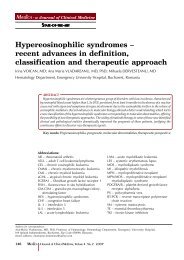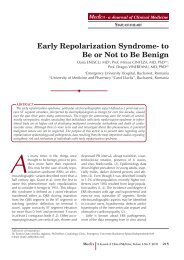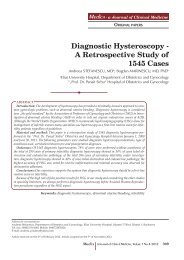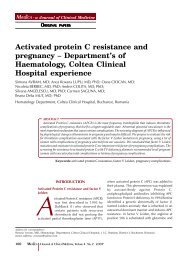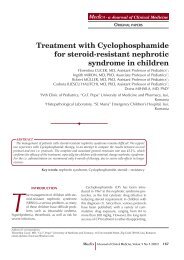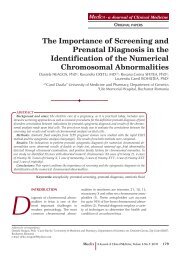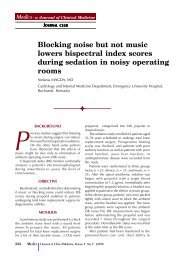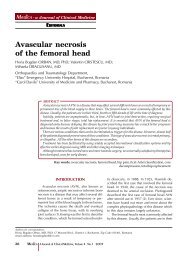Cuprins
Cuprins
Cuprins
You also want an ePaper? Increase the reach of your titles
YUMPU automatically turns print PDFs into web optimized ePapers that Google loves.
JURNALUL MEDICINEI ROMÂNEªTI – VOL. III, NR. 1-2, AN 2005<br />
23<br />
deiodinases, and thioredoxin reductases. Selenium<br />
depletion in animals is associated with decreased<br />
activities of Se-dependent enzymes and leads to<br />
enhanced cell loss in models of neurodegenerative<br />
disease. Genetic inactivation of cellular glutathione<br />
peroxidase increases the sensitivity towards neurotoxins<br />
and brain ischemia. Conversely, increased<br />
GPx activity as a result of increased Se supply or<br />
over-expression ameliorates the outcome in the<br />
same models of disease. Genetic inactivation of<br />
selenoprotein P leads to a marked reduction of brain<br />
Se content, which has not been achieved by dietary<br />
Se depletion, to a movement disorder and spontaneous<br />
seizures.<br />
Manganese<br />
Manganese is an essential mineral that is found<br />
at low levels in virtually all diets. Mn ingestion represents<br />
the principal route of human exposure,<br />
although inhalation also occurs, predominantly in<br />
occupational cohorts. Regardless of intake, animals<br />
generally maintain stable tissue Mn levels as a result<br />
of homeostatic mechanisms that tightly regulate the<br />
absorption and excretion of this metal (Chen et all,<br />
2002). However, high dose exposures are associated<br />
with increased tissue Mn levels, resulting in adverse<br />
neurological, reproductive, and respiratory effects.<br />
In humans, Mn-induced neurotoxicity, commonly<br />
referred to as manganism or Parkinson’s diseaselike<br />
syndrome, is of paramount concern and is considered<br />
to be one of the most sensitive endpoints.<br />
Mn neurotoxicity is associated with motor dysfunction<br />
syndrome that is recognized as a form of<br />
parkinsonism (Tomas-Camardiel et all 2002).<br />
Nickel<br />
Nickel represent a trace elements with a plasma<br />
level of 0.002-0.003 microg. It is usually associated<br />
in blood flow with albumin or metalloproteins. Daily<br />
intake of Ni is around 0.3-0.5 microg, but a big<br />
amount is lost via digestive, renal and skin route.<br />
Ni has an important role in thermo stability of DNA<br />
and RNA; also it plays a key role in mention of<br />
structure and functioned of cells membranes (Ulmer<br />
1984). The combination between Ni and carbon<br />
monoxide is extremely dangerous inducing<br />
pulmonary inflammation and hepatic necrosis.<br />
PERSONAL RESEARCH<br />
Starting from the favourable effects of the oligoelements<br />
complex therapy in the ageing process<br />
we have investigated the variations in concentration<br />
and distribution of some macro and microelements<br />
in the walls of cerebral vessels in connection with<br />
the ageing. When conducting these researches the<br />
following steps where required: collection, weighing,<br />
conservation, disintegration, determining the concentrations<br />
and establishing some similarities<br />
(Popescu CD 1991).<br />
MATERIALS AND METHODS<br />
Our research has been conducted on a necroptic<br />
material which included 10 cases with ages varying<br />
from 2 to 80 years old. In all cases there have been<br />
collected fragments with lengths between 2-3 cm<br />
from the big arteries of the brain or the arteries with<br />
cerebral destination. After the collection there has<br />
been performed the longitudinal section of the<br />
vessels and cleaning the blood stains or serosity,<br />
by light cleaning the surfaces. The samples have<br />
been bottled in glass recipients with a stopper (previously<br />
weighed). After, the fragment has been<br />
introduced the tube have been once more weighted.<br />
The weight differences, established with the help<br />
of analytical scales, have permitted to weight the<br />
samples. They have been kept for 2-10 days at a<br />
temperature of 4oC and then we preceded the next<br />
step with sulphuric acid and peroxide that permit<br />
to obtain a clear solution for analytical tests in order<br />
to evaluate the concentrations of oligoelements. The<br />
oligoelements measurement have been done though<br />
two methods: spectrometry of atomic absorption<br />
under fire and that of emission.<br />
Iron<br />
In cerebral artery the amount of Fe vary between<br />
1.1-8.6 mg% being the fourth after Na, Ca and Mg.<br />
Commune and internal carotid artery present comparable<br />
concentration; the biggest amount was<br />
found in Willis polygon artery, and the lowest in<br />
vertebro-basilar arteries and anterior cerebral artery.<br />
There is a clear tendency of increase iron concentration<br />
in cerebelar artery with age especially<br />
after 35 years. The increase amount of Fe with age<br />
both in intra and extracerebral artery could be<br />
explained by metabolic disturbances and enzyme<br />
dysfunction associated with accumulation of<br />
catabolism productions. There is also possible the<br />
sequestration of erythrocytes with reduce elasticity<br />
at vasa vasorum level.<br />
Magnesium<br />
In the walls of the cerebral arteries it is found in<br />
significant amounts comparing to the oligoemelemets<br />
having values between 47.45·10 -4 and 383·10 -4 g%.




